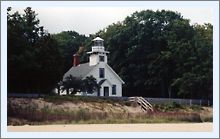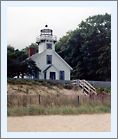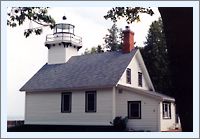|
Historical
Information

An 18 mile long peninsula protrudes in a northerly direction splitting
Grand Traverse bay into east and west arms. Sitting on the 45th
parallel and sheltered from major winds by the east and west points of
the bay, the area had long been home to bands of Ottawa, who took up
permanent residence on the narrow peninsula, planting potatoes and corn,
and tapping the maples for their sweet sugar syrup. In accordance with
the Treaty of 1836, the Federal Government agreed to provide the natives
with both a mission and schools for their reservation, and on behalf of
the federal government Henry Schoolcraft selected a natural harbor on
the eastern shore of the peninsula for the planned facilities.
Dispatched by the Presbyterian Board of Missions, the Reverend Peter
Dougherty arrived in the harbor in 1838 to establish the mission for
which the peninsula would eventually become known.
Word of the excellent growing conditions in the area around Grand
Traverse Bay spread, and increasing numbers of settlers began moving
into the territory to stake their claim. As was so often the case, the
Federal Government reevaluated the old treaties, and determined that the
Indian lands around the bay should become public property. With the
organization of Grand Traverse and Peninsula townships in 1853, yet more
settlers moved into the area to take up farming, and both arms of the
bay were soon busy with vessels arriving to ship produce to the growing
cities on the southern shores of the lakes.
With shoals projecting two miles from the northernmost tip of the Old
Mission Peninsula, mariners making their way south into Grand Traverse
Bay had to exercise great caution in navigating around the peninsula
when making their way into either east or west arm of the bay.
Responding to a call from the maritime community, Congress appropriated
the sum of $6,000 to establish a light on Old Mission Point on March 3,
1859. However, with the onset of the Civil War, the establishment of the
station understandably took on reduced priority.
With an increasing number of requests for the establishment of
lighthouses throughout the Great Lakes, in 1863 the Lighthouse Board
appointed a committee to conduct a review of recommended sites to report
on the relative merits of each. Assigned to evaluate the site at Mission
Point, Colonel James D. Graham of the Army
Corps of Engineers reported that "there is an extensive
trade in the two arms of this bay, the coasts and back country of which
are thickly settled. At the heads of both these arms there are excellent
harbors and good anchorage, and vessels should be aided in reaching
them." With the end of the Civil War, and the country’s economy
slowly improving, a site for the light on Old Mission Point was finally
selected in 1869, and negotiations were underway with the owner to
obtain clear title to the reservation.
 Work on the new station began on the opening of the 1870 navigation
season. Plans for the station called for the erection of a 1 ˝-story
timber-framed dwelling with a short wooden tower integrated into the
lakeward gable end. The tower was capped with an decagonal cast iron
lantern, and stood 36 feet tall from the foundation to the top of the
ventilator ball. Outfitted with a fixed white Fifth
Order Fresnel lens, the structure’s location on a sand bank
fourteen feet above the water’s surface provided the lens with focal
plane of 47 feet, and was visible from a distance of 13 miles at sea. Work on the new station began on the opening of the 1870 navigation
season. Plans for the station called for the erection of a 1 ˝-story
timber-framed dwelling with a short wooden tower integrated into the
lakeward gable end. The tower was capped with an decagonal cast iron
lantern, and stood 36 feet tall from the foundation to the top of the
ventilator ball. Outfitted with a fixed white Fifth
Order Fresnel lens, the structure’s location on a sand bank
fourteen feet above the water’s surface provided the lens with focal
plane of 47 feet, and was visible from a distance of 13 miles at sea.
Jerome M. Pratt Sr., who had been serving as First Assistant at Skillagalee
Island since 1861 was selected as the station’s first Keeper.
After arriving at Mission Point on September 3, Pratt moved his
belongings into the new dwelling, and officially exhibited the new light
for the first time on the night of September 10, 1870.
After seven years, Pratt was removed as Keeper at Old Mission on
January 30, 1877, and replaced by John M. McHaney, who was likely only
to willing to accept a transfer to the bucolic setting of Old Mission
from the isolation of Waugoshance
Shoal where he had been serving as Keeper since 1865. Life at
Mission Point appears to have been relatively uneventful, as little
mention of the station is made in official Lighthouse Board documents,
beyond relatively minor maintenance and repairs being conducted on an
almost annual basis until 1880, when a work crew arrived to excavate a
cellar beneath the dwelling, and completely repainted the station inside
and out.
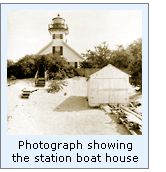 Keeper McHaney did not get to enjoy the improvements at the station
for too long, as he passed away on August 15 of the following year. John
W. Lane, who was serving as 1st Assistant Keeper of the St.
Clair Flats South Canal Range Lights was promoted to the position of
Acting Keeper of the Mission Point Light, arriving at Mission Point with
his wife Sarah after making the long trip from "down state."
Evidently District Inspector Commander J. Crittenden Watson was pleased
with Lane’s performance, as he was officially given full Keeper status
on June 19, 1883. Keeper McHaney did not get to enjoy the improvements at the station
for too long, as he passed away on August 15 of the following year. John
W. Lane, who was serving as 1st Assistant Keeper of the St.
Clair Flats South Canal Range Lights was promoted to the position of
Acting Keeper of the Mission Point Light, arriving at Mission Point with
his wife Sarah after making the long trip from "down state."
Evidently District Inspector Commander J. Crittenden Watson was pleased
with Lane’s performance, as he was officially given full Keeper status
on June 19, 1883.
With rising lake levels in the late 1880’s erosion was threatening
the sand bank on which the station was erected, and a crew arrived at
Mission Point in 1889 to erect a 200 foot long timber revetment was
erected in front of the dwelling, and filled with stone to help stave
off further erosion. While on site, the crew also installed a brick
cistern in the cellar. The downspouts from the dwelling roof were
equipped with diverters, allowing runoff from the roof to flow directly
into the cistern or to be diverted onto the ground. On completion of the
installation, a pump was installed at the sink in the kitchen and
plumbed so as to draw its water from the cistern. In practice, the
keepers kept the diverters closed so when rain came they would allow the
rainwater to clean the roof for a period of time before opening the
diverters to allow the water to enter the cistern. While to our
twenty-first century sensibilities, the practice of drinking and cooking
with water that had run from the roof sounds disgusting, it was a
commonplace practice at light stations in the late 1800's.
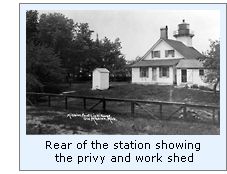 Oil for the lamp had been stored in the cellar since its installation
beneath the dwelling in 1880. The sperm or lard oil used for this
purpose was relatively non-volatile, and this had become standard
practice throughout the lighthouse system. However, with a change to the
significantly more volatile kerosene, a number of devastating dwelling
fires were experienced, and beginning late in the 1880's the Lighthouse
Board began building separate oil storage buildings at all US light
stations. To this end, materials for the erection of an oil storage
building at Mission Point were ordered at the lighthouse depot in 1897,
and with the delivery of the materials and a work crew at the station in
1899, a 360-gallon storage building was erected to the rear of the
dwelling. Oil for the lamp had been stored in the cellar since its installation
beneath the dwelling in 1880. The sperm or lard oil used for this
purpose was relatively non-volatile, and this had become standard
practice throughout the lighthouse system. However, with a change to the
significantly more volatile kerosene, a number of devastating dwelling
fires were experienced, and beginning late in the 1880's the Lighthouse
Board began building separate oil storage buildings at all US light
stations. To this end, materials for the erection of an oil storage
building at Mission Point were ordered at the lighthouse depot in 1897,
and with the delivery of the materials and a work crew at the station in
1899, a 360-gallon storage building was erected to the rear of the
dwelling.
With increasing numbers of vacationers visiting Mission Point at the
turn of the twentieth century, 198 feet of tight board fence and 344
feet of wire fence were erected around the station in 1901, and 350 feet
of plank walkways were installed connecting the station structures.
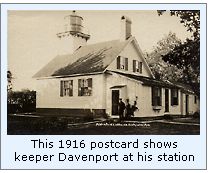 Keeper Lane passed away on December 12, 1906, and his wife Sarah was
appointed as acting Keeper to replace him. Sarah likely found tending
the light to be too filled with memories of her late husband, as she
resigned that following March, to be replaced by sixty year old James
Davenport on March 13, 1907. Davenport entered lighthouse service in
1871, and had served at Waugoshance and Little
Sable before accepting the Keeper’s position at McGulpin’s
Point Light in 1879. Davenport had established a reputation at
McGulpin’s Point, and had become a well respected member of the
Mackinaw community, and would likely have lived out his service years at
McGulpin’s Point were the station not closed down in 1906, and thus
accepted the transfer to Mission Point. William F Green transferred-in
from South Fox Island, and James Davenport returned to Mackinaw City,
where he lived-out the remainder of his life, passing away on March 18,
1932 at the age of eighty-five. Keeper Lane passed away on December 12, 1906, and his wife Sarah was
appointed as acting Keeper to replace him. Sarah likely found tending
the light to be too filled with memories of her late husband, as she
resigned that following March, to be replaced by sixty year old James
Davenport on March 13, 1907. Davenport entered lighthouse service in
1871, and had served at Waugoshance and Little
Sable before accepting the Keeper’s position at McGulpin’s
Point Light in 1879. Davenport had established a reputation at
McGulpin’s Point, and had become a well respected member of the
Mackinaw community, and would likely have lived out his service years at
McGulpin’s Point were the station not closed down in 1906, and thus
accepted the transfer to Mission Point. William F Green transferred-in
from South Fox Island, and James Davenport returned to Mackinaw City,
where he lived-out the remainder of his life, passing away on March 18,
1932 at the age of eighty-five.
Evidently Green missed South
Fox Island, as he accepted a transfer back to the station in
1924, and the search was on for yet another keeper at Mission Point.
Emil C. Johnson accepted a promotion to Mission Point from Grand
Traverse Light, where he had been serving as First Assistant
since 1916, arriving at Mission Point on June 27, 1924.
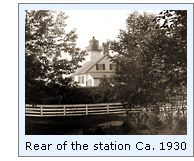 After sixty-seven years of service lighting the Point, plans were
under formulation which would eliminate the need for the Mission Point
Light. Since the station had been established to mark the shoals off the
point, improvements in offshore construction and automated lighthouse
illumination had come together to allow the erection of an offshore
navigation aid to directly mark the shoal itself. Thus, in 1938, work
began on construction of a pier for the new light in 19 feet of water,
approximately 1 7/8 miles northwest of Mission Point. The pier was made
up of a circular pier of interlocking steel piling with its center
filled with stone and concrete. Atop the pier deck, four concrete
cylinders were poured as a foundation for a 36-foot tall skeletal steel
pyramid tower. Topped with a 200 mm lantern, power for the lamp was
supplied by a 330 candlepower electric light with its power provided by
a rank of batteries. In order to conserve energy, and therefore reduce
the frequency at which the batteries required recharging, the light
emitted a single white flash every ten seconds. With a focal plane of 52
feet, the new unmanned light was visible for 13 miles at sea. After sixty-seven years of service lighting the Point, plans were
under formulation which would eliminate the need for the Mission Point
Light. Since the station had been established to mark the shoals off the
point, improvements in offshore construction and automated lighthouse
illumination had come together to allow the erection of an offshore
navigation aid to directly mark the shoal itself. Thus, in 1938, work
began on construction of a pier for the new light in 19 feet of water,
approximately 1 7/8 miles northwest of Mission Point. The pier was made
up of a circular pier of interlocking steel piling with its center
filled with stone and concrete. Atop the pier deck, four concrete
cylinders were poured as a foundation for a 36-foot tall skeletal steel
pyramid tower. Topped with a 200 mm lantern, power for the lamp was
supplied by a 330 candlepower electric light with its power provided by
a rank of batteries. In order to conserve energy, and therefore reduce
the frequency at which the batteries required recharging, the light
emitted a single white flash every ten seconds. With a focal plane of 52
feet, the new unmanned light was visible for 13 miles at sea.
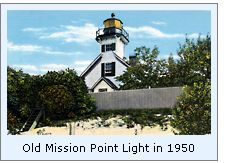 At some time over the intervening years, the skeleton tower was
removed from the crib of the new light, and replaced by a cylindrical
D-9 type tower outfitted with a solar powered acrylic optic. At some time over the intervening years, the skeleton tower was
removed from the crib of the new light, and replaced by a cylindrical
D-9 type tower outfitted with a solar powered acrylic optic.
The State of Michigan purchased the old lighthouse property after the
Second World War, as part of a new park. The dwelling is maintained by
Peninsula Township, and is used as a residence by park employees. While
the dwelling and the lighthouse grounds themselves are closed to the
public, the area on all four sides of the old station are open to the
public, as is the beach in front of the lighthouse.

Keepers of this
Light

Click Here
to see a complete listing of
all Mission Point Light keepers compiled by Phyllis L. Tag of Great
Lakes Lighthouse Research.

Seeing this
Light

We headed up Mission
Peninsula with Sue's Folks. We were amazed at all the wineries and grape
groves that had sprung-up since we last visited the peninsula some 20
years before.
The lighthouse, which is currently a private dwelling for the Park
manager, is surrounded by a wooden fence, which is unfortunately
obtrusive when viewed from the lake. We walked the beach to the East of the point, and saw lots of shore
birds.
To the West of the Point, there was a small rocky island with a fairly
new sailboat smashed against one side. I could almost hear the blinded
lighthouse chuckling!

Finding this
Light

Take M37 North up the Mission Peninsula approximately 16 miles to the
road's end at the lighthouse parking area. Walk through the trees
alongside the lighthouse and onto the beach.

Reference Sources

Inventory
of Historic Light Stations, National Parks Service, 1994
Annual reports of the Lighthouse Board, various, 1862 - 1909.
Annual report of the Lake Carriers Association, 1938
Great Lakes Light Lists, various, 1876 - 1997
Northern Lights, Charles K Hyde, 1995
Email from Russ Rowlett, 06/01/2000
Personal observation at Old Mission, 09/07/1998.
Keeper listings for this light appear courtesy of Great
Lakes Lighthouse Research
|
